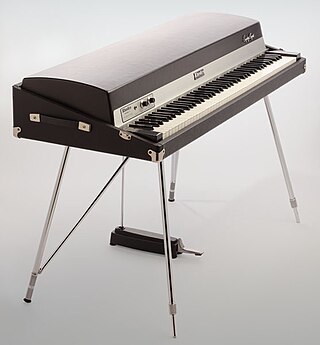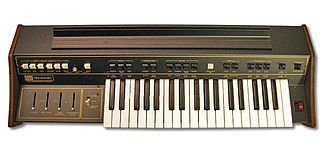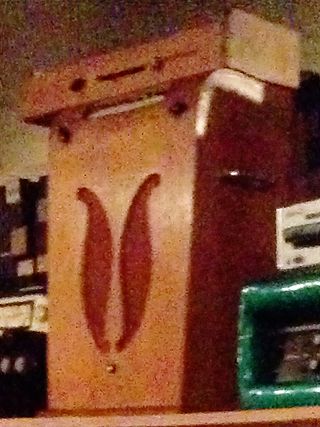
An effects unit, effects processor, or effects pedal is an electronic device that alters the sound of a musical instrument or other audio source through audio signal processing.

The Rhodes piano is an electric piano invented by Harold Rhodes, which became popular in the 1970s. Like a conventional piano, the Rhodes generates sound with keys and hammers, but instead of strings, the hammers strike thin metal tines, which vibrate next to an electromagnetic pickup. The signal is then sent through a cable to an external keyboard amplifier and speaker.

Vox is a British musical equipment manufacturer founded in 1957 by Thomas Walter Jennings in Dartford, Kent, England. The company is most famous for making the Vox AC30 guitar amplifier, used by The Beatles, The Rolling Stones, The Kinks, The Yardbirds, Queen, Dire Straits, U2, and Radiohead; the Vox Continental electric organ, the Vox wah-wah pedal used by Jimi Hendrix, and a series of innovative electric guitars and bass guitars. Since 1992, Vox has been owned by the Japanese electronics firm Korg.
Farfisa is a manufacturer of electronics based in Osimo, Italy, founded in 1946. The company manufactured a series of compact electronic organs in the 1960s and 1970s, including the Compact, FAST, Professional and VIP ranges, and later, a series of other keyboard instruments. They were used by a number of popular musicians including Sam the Sham, Country Joe and the Fish, Pink Floyd, Sly Stone, Blondie, and the B-52s.
Paul Henry Beaver Jr. was an American musician who was a pioneer in popular electronic music, using the Moog synthesizer. From 1967, Beaver collaborated with Bernie Krause as the recording duo Beaver & Krause.

"Telstar" is a 1962 instrumental by the English band the Tornados, written and produced by Joe Meek. It reached number one on the UK Singles Chart and the US Billboard Hot 100 in December 1962. It was the second instrumental single to hit number one in 1962 on both the US and UK weekly charts.

Electronic Sound is the second studio album by English rock musician George Harrison. Released in May 1969, it was the last of two LPs issued on the Beatles' short-lived Zapple record label, a subsidiary of Apple Records that specialised in the avant-garde. The album is an experimental work comprising two lengthy pieces performed on a Moog 3-series synthesizer. It was one of the first electronic music albums by a rock musician, made at a time when the Moog was usually played by dedicated exponents of the technology. Harrison subsequently introduced the Moog to the Beatles' sound, and the band featured synthesizer for the first time on their 1969 album Abbey Road.

The Moog synthesizer is a modular synthesizer invented by the American engineer Robert Moog in 1964. Moog's company, R. A. Moog Co., produced numerous models from 1965 to 1981, and again from 2014. It was the first commercial synthesizer and established the analog synthesizer concept.

The VL-1 was the first instrument of Casio's VL-Tone product line, and is sometimes referred to as the VL-Tone. It combined a calculator, a monophonic synthesizer, and sequencer. Released in June 1979, it was the first commercial digital synthesizer, selling for $69.95.

The ARP Pro Soloist was one of the first commercially successful preset synthesizers. Introduced by ARP Instruments, Inc. in 1972, it replaced the similar ARP Soloist (1970–1971) in the company's lineup of portable performance instruments.

The Ondioline is an electronic analog synthesizer, developed and built by Frenchman Georges Jenny. Sometimes referred to as the "Jenny Ondioline," the instrument is considered a forerunner of the synthesizer. First conceived by Jenny in 1939, he continued refining and reconfiguring the device, producing dozens of variant models up until his death in 1975.

The Fender Contempo Organ is a combo organ made by Fender during the late 1960s. It was designed to compete with similar instruments such as the Vox Continental and Farfisa Compact, and had additional stops, features and controllers not found on the other models. However, it was only in production for a few years as it struggled to compete with the more popular Hammond organ and Rhodes piano.
Jennings Musical Instruments is a manufacturer of musical instruments, and the original owner of the Vox brand. The company was founded by Thomas Walter Jennings.
A combo organ, so-named and classified by popular culture due to its original intended use by small, touring jazz, pop and dance groups known as "combo bands", as well as some models having "Combo" as part of their brand or model names, is an electronic organ of the frequency divider type, generally produced between the early 1960s and the late 1970s. This type of organ predated, and contributed largely to, the development of modern synthesizers. The combo organ concept, at least in the context of mass-production, is thought to have arisen from popular demand, when smaller home organs were seen in music stores. Combo organs were probably originally developed in the United Kingdom, based on the Univox polyphonic version of the Clavioline, and some models included the inner-workings of Italian-made transistor accordions. They were the brainchild of necessity for portable organs of simple design, mainly for use in these small groups. Combo organs ended up having a major impact on the music scene of the mid- and late 1960s, particularly on rock and roll of that era.
Constant Martin was a French engineer and inventor who perfected and successfully commercialised radio sets and most famously the Clavioline, a precursor to the synthesizer. He is the grandfather of director Michel Gondry and Oliver "Twist" Gondry.

Harald Bode was a German engineer and pioneer in the development of electronic musical instruments.

The Hohner Multimonica featured a combination of a fan-blown reed organ and a monophonic sawtooth wave analog synthesizer. Produced by the German Hohner GmbH in the 1940s and 1950s, it preceded even the more famous Selmer Clavioline. Its circuitry was designed by the German engineer Harald Bode.

Vintage musical equipment is older music gear, including instruments, amplifiers and speakers, sound recording equipment and effects pedals, sought after, maintained and used by record producers, audio engineers and musicians who are interested in historical music genres. While any piece of equipment of sufficient age can be considered vintage, in the 2010s the term is typically applied to instruments and gear from the 1970s and earlier. Guitars, amps, pedals, electric keyboards, sound recording equipment from the 1950s to 1970s are particularly sought. Musical equipment from the 1940s and prior eras is often expensive, and sought out mainly by museums or collectors.

Electric music technology refers to musical instruments and recording devices that use electrical circuits, which are often combined with mechanical technologies. Examples of electric musical instruments include the electro-mechanical electric piano, the electric guitar, the electro-mechanical Hammond organ and the electric bass. All of these electric instruments do not produce a sound that is audible by the performer or audience in a performance setting unless they are connected to instrument amplifiers and loudspeaker cabinets, which made them sound loud enough for performers and the audience to hear. Amplifiers and loudspeakers are separate from the instrument in the case of the electric guitar, electric bass and some electric organs and most electric pianos. Some electric organs and electric pianos include the amplifier and speaker cabinet within the main housing for the instrument.
Georges Marcel Charles Jenny was a French musician, poet, and electronic instrument builder. His best-known invention was an electronic keyboard instrument called the Ondioline. It is considered a forerunner of the synthesizer. The Ondioline is monophonic, yet it is capable of generating an array of sounds, and features a keyboard that produces a natural-sounding vibrato via side-to-side finger movements when keys are depressed.















